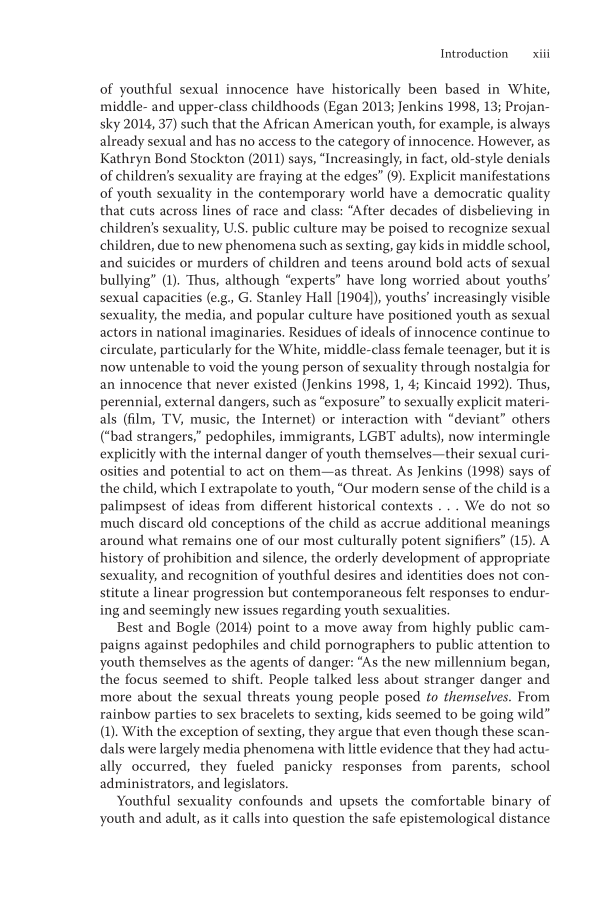Introduction xiii of youthful sexual innocence have historically been based in White, middle- and upper-class childhoods (Egan 2013 Jenkins 1998, 13 Projan- sky 2014, 37) such that the African American youth, for example, is always already sexual and has no access to the category of innocence. However, as Kathryn Bond Stockton (2011) says, “Increasingly, in fact, old-style denials of children’s sexuality are fraying at the edges” (9). Explicit manifestations of youth sexuality in the contemporary world have a democratic quality that cuts across lines of race and class: “After decades of disbelieving in children’s sexuality, U.S. public culture may be poised to recognize sexual children, due to new phenomena such as sexting, gay kids in middle school, and suicides or murders of children and teens around bold acts of sexual bullying” (1). Thus, although “experts” have long worried about youths’ sexual capacities (e.g., G. Stanley Hall [1904]), youths’ increasingly visible sexuality, the media, and popular culture have positioned youth as sexual actors in national imaginaries. Residues of ideals of innocence continue to circulate, particularly for the White, middle-class female teenager, but it is now untenable to void the young person of sexuality through nostalgia for an innocence that never existed (Jenkins 1998, 1, 4 Kincaid 1992). Thus, perennial, external dangers, such as “exposure” to sexually explicit materi- als (film, TV, music, the Internet) or interaction with “deviant” others (“bad strangers,” pedophiles, immigrants, LGBT adults), now intermingle explicitly with the internal danger of youth themselves—their sexual curi- osities and potential to act on them—as threat. As Jenkins (1998) says of the child, which I extrapolate to youth, “Our modern sense of the child is a palimpsest of ideas from different historical contexts . . . We do not so much discard old conceptions of the child as accrue additional meanings around what remains one of our most culturally potent signifiers” (15). A history of prohibition and silence, the orderly development of appropriate sexuality, and recognition of youthful desires and identities does not con- stitute a linear progression but contemporaneous felt responses to endur- ing and seemingly new issues regarding youth sexualities. Best and Bogle (2014) point to a move away from highly public cam- paigns against pedophiles and child pornographers to public attention to youth themselves as the agents of danger: “As the new millennium began, the focus seemed to shift. People talked less about stranger danger and more about the sexual threats young people posed to themselves. From rainbow parties to sex bracelets to sexting, kids seemed to be going wild” (1). With the exception of sexting, they argue that even though these scan- dals were largely media phenomena with little evidence that they had actu- ally occurred, they fueled panicky responses from parents, school administrators, and legislators. Youthful sexuality confounds and upsets the comfortable binary of youth and adult, as it calls into question the safe epistemological distance
Document Details My Account Print multiple pages
Print
You have printed 0 times in the last 24 hours.
Your print count will reset on at .
You may print 0 more time(s) before then.
You may print a maximum of 0 pages at a time.
















































































































































































































































































































































































































































































































































































































